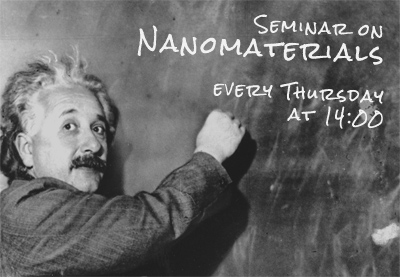Nanoseminar
Group of Structure analysis at the Department of Condensed Matter Physics
of Charles University and MGML has a pleasure to invite you to attend the seminar on nanomaterials: Physics, Technology, Applications
on 20th November 2025 at 14:00
at Faculty of Mathematics and Physics of Charles University, Ke Karlovu 5, 121 16 Praha 2
Lecture room F2
Václav Valeš
Institute of Physics, Czech Academy of Sciences, Praha, Czechia
Electronic properties of UHV-exfoliated transition metal thio(seleno)phosphate monolayers on gold substrates
Václav Valeš » Electronic properties of UHV-exfoliated transition metal thio(seleno)phosphate monolayers on gold substrates
Institute of Physics, Czech Academy of Sciences, Praha, Czechia
*corresponding author: e-mail: vales@fzu.cz
Location: Lecture room F2 (first floor of MFF UK, Ke Karlovu 5)
1 Institute of Physics, Czech Academy of Sciences, Praha, Czechia
2 Charles University, Faculty of Mathematics and Physics, Czechia
3 J. Heyrovsky Institute of Physical Chemistry, Czech Academy of Sciences, Praha, Czechia
Electronic properties of UHV-exfoliated transition metal thio(seleno)phosphate monolayers on gold substrates
Two-dimensional (2D) transition metal thio(seleno)phosphate (TMPX3) layers have emerged as a class of materials for fundamental studies of their electronic [1] and magnetic properties and for potential applications in spintronics [2]. However, their limited stability in ambient conditions, especially as monolayers, represents a major obstacle to conventional preparation and characterization approaches [3]. Controlling interfaces between monolayer TMPX3 and substrates is promising since interface-induced strain, charge transfer processes and confinement effects are expected to modulate intrinsic magnetic interactions [4].
Here we report on a fabrication and characterization of FePS₃, MnPS₃, and FePSe₃ monolayer flakes prepared by in situ exfoliation under ultra-high vacuum (UHV) conditions onto atomically clean gold substrates. This contamination-free technique allows the isolation of 2D layers even for air-sensitive material cases. The layers were characterized in situ by X-ray photoelectron spectroscopy (XPS), angle-resolved photoemission spectroscopy (ARPES), and Raman spectroscopy at room temperature. XPS confirmed the elemental composition of an intact TMPX3 structure. ARPES revealed the electronic band structure in the monolayer limit, showing distinct differences mainly near the valence band edge to reference measurements on respective bulk-like layers. Additionally, resonant photoemission spectroscopy was used to identify the Fe and Mn 3d states and probe hybridization effects.
References:
[1] J. E. Nitschke et al., (2023), Materials Today Electronics, 6, 100061
[2] R. Basnet and J. Hu, (2024), Nanoscale, 16, 15851-15883
[3] J. U. Lee et al., (2016), Nano Lett, 16, 7433–7438
[4] J. Strasdas et al., (2023), Nano Lett, 23, 10342–10349


